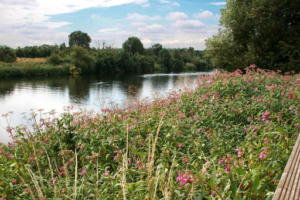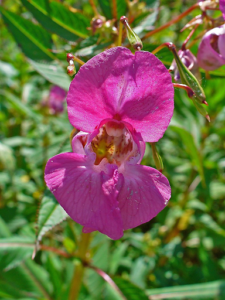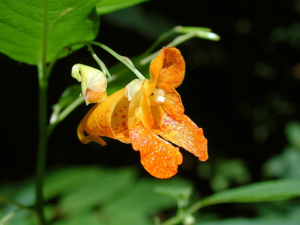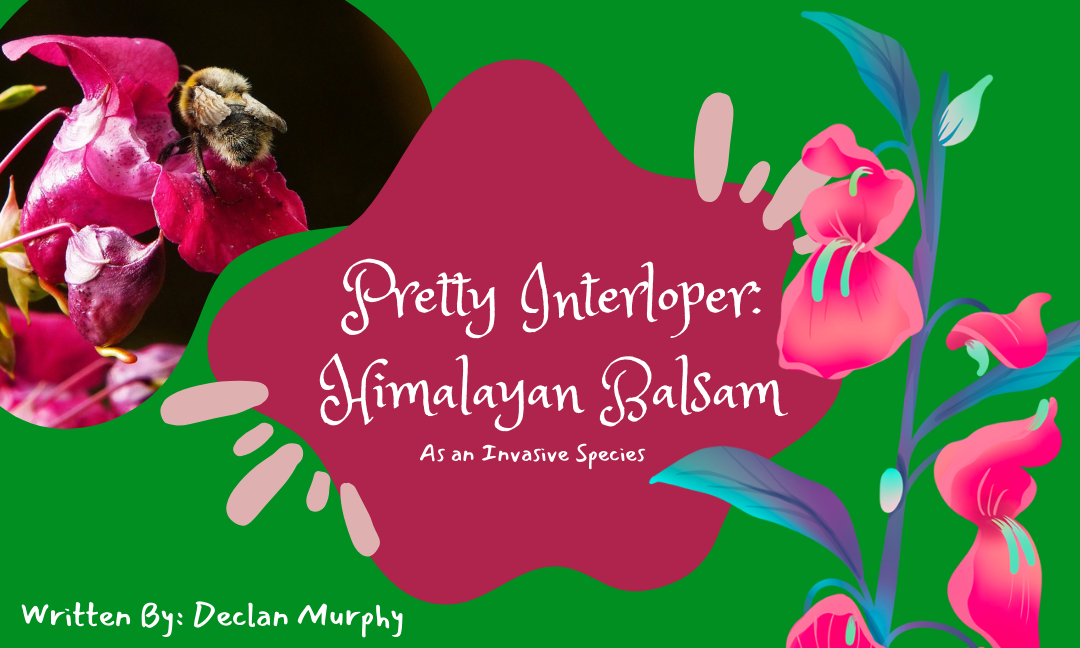Written by Declan Murphy
Edited by Julia Georgescu
Designed by Tvisha Lakhani
Published by Kiritika Rana
The tall, pink flower of the Himalayan Balsam (Impatiens glandulifera) is lovely, but it doesn’t belong here in Ontario, and that’s a problem.

According to the US National Ocean Service, an invasive species is “an organism that causes ecological or economic harm in a new environment where it is not native”. Some examples in Ontario include the Asian carp, the Emerald Ash Borer, and the Giant Hogweed.
Himalayan Balsam can now be found across Canada, including in Ontario, and has naturalized in the United States. The UK is currently waging a significant war against Himalayan Balsam, which isn’t an easy undertaking.
As its name suggests, the Himalayan Balsam plant is originally from the western Himalayan region of Asia. It was introduced to North America, New Zealand and Europe as a garden plant, because of its beautiful orchid-like flowers. It became a popular flower in Victorian gardens, and was first spread intentionally before becoming a very efficient and aggressive “wildflower”.
It spreads easily and quickly due to its “touch-me-not” seed pods, similar to the native orange Jewelweed plant. This refers to the fact that its pods explode on touch and this spreads its seeds far and wide (as much as 5 metres!), meaning that the seedlings don’t have to compete with the parent plant. This gives it a major advantage over many other plants. Each plant produces up to 800 seeds!
The Himalayan Balsam also produces a large amount of nectar, which allows it to further out-compete many native plants by drawing away pollinators with a “better offer”.
The success of Himalayan Balsam is a problem because it crowds out indigenous plants and decreases biodiversity. It also encourages soil erosion by eliminating some of the plants that typically protect river banks in Ontario. Because it likes wet soil, it can be common along waterways, but its root systems are not sufficient to protect the banks from wear and tear from the water. Because it’s an annual, the plant offers no protection to river banks in the winter.
Unfortunately, however, its location near waterways is often key to its spread, and the seeds can quickly colonize a vast length along a river or stream due to seed drift in the space of only a few years.

According to the Grand River Conservation Authority, our own beloved Grand River Watershed is now being threatened by Himalayan Balsam invasion, which could quickly lead to the decline in biodiversity and habitat quality along the Grand River, as well as threaten the integrity of the river banks. The Grand River, and its health and stability, is essential to our local ecosystem.
In the UK, Himalayan Balsam has taken to growing in ditches and on field margins, increasingly threatening agricultural production, as well.

Researchers R.A. Tanner and A.C. Gange found, “It is clear that I. glandulifera represents a significant threat to native ecosystems in many temperate areas of the world.”
So, what should we do about the Himalayan Balsam?
There are many research programs focused on controlling this species, including introducing rust fungus into their colonies, which seems like it could end up causing more problems. Chemically, the Himalayan Balsam can be controlled by a foliar spray of glyphosate solution in early spring, just as the leaves show, but before the plant has had a chance to flower. However, there is a risk to the health of humans and pets, as well as the environment, with such chemical herbicides. We need to make sure that the cure isn’t worse than the disease!
Educational programs discouraging people from collecting and spreading the seeds, as well as the promotion of indigenous plants in gardens and green spaces, are some major things we can do to prevent the spread of this invasive species.
Like most invasive species, prevention is the best medicine for this interloper. It’s best to just not plant them and not allow them to flourish. Despite their obvious beauty, don’t collect seeds from the Himalayan Balsam, don’t pop their seed pods (even though it’s fun to watch them explode), avoid letting pets or kids run through stands of Himalayan Balsam, and do weed them whenever you can, especially before seed pods have formed (in early to mid-July). Of course, the Himalayan Balsam should not be composted, especially if it has seeds!
If you find Himalayan Balsam in a park or wild space, you can report it at the Invading Species Hotline at 1-800-563-7711, or visit EDDMapS.

If you’d like a pretty native alternative in your garden or greenspace, try the equally lovely orange Impatiens capensis, Jewelweed (or “Spotted Touch-me-not,” shown above), instead!
Please, feel free to share your favourite native plant for Ontario gardeners in the comments below.
Sources:
Anon. (2021) Impatiens glandulifera – Wikipedia Wikipedia.
BBC. (2022). Call to check land in Guernsey for invasive Himalayan balsam plant.
CBC News (2014). Hunting the Invasive Himalayan Balsam in Ottawa.
Geller-Grimm, F. (2002) Impatiens capensis – Wikipedia
Government of Wales. (2022.) Public information on invasive species in Wales – Himalayan balsam
Grand River Conservation Authority. (2023.) Invasive plants – Grand River Conservation Authority
Invasive Species Centre. (2023). Invasive Species Centre
Invasive Species Centre. (2023). Himalayan Balsam – Profile and Resources | Invasive Species Centre
JaStra. (2016). Indian Balsam Himalayan. Pixabay.
Lally, D. (2010.) A dense patch of Himalayan Balsam by the… © David Lally :: Geograph Britain and Ireland
Lesser, J. (2023) How to Grow and Care for Jewelweed The Spruce.
Matthews, J., et al. (2015). Risks and management of non-native Impatiens species in the Netherlands. Reports Environmental Science 491.
National Ocean Service. (N.D.) What is an invasive species?
Ontario’s Invading Species Awareness Program. (2023). Himalayan Balsam.
Ontario Invasive Plants. (2021). Himalayan Balsam.
Province of Ontario. (2023.) Invasive species in Ontario | ontario.ca
Robson, M. (2022). Advocates thrilled as court orders Health Canada to reassess glyphosate decision | CTV News.
Rotherham, Ian D. (2001). “Himalayan Balsam-the human touch.” Exotic Invasive Species-should we be concerned. Institute of Ecology and Environmental Management Conference, Birmingham, April, 2000.: 41-50.
Simak, E. (2007.) Himalayan Balsam (Impatiens glandulifera). Wikipedia.
Tanner, R. A., and A. C. Gange. (2020.) “Himalayan balsam, Impatiens glandulifera: Its ecology, invasion and management.” Weed Research 60.1: 4-7.
Zell, H. (2009.) File:Impatiens glandulifera 0004.JPG – Wikimedia Commons

